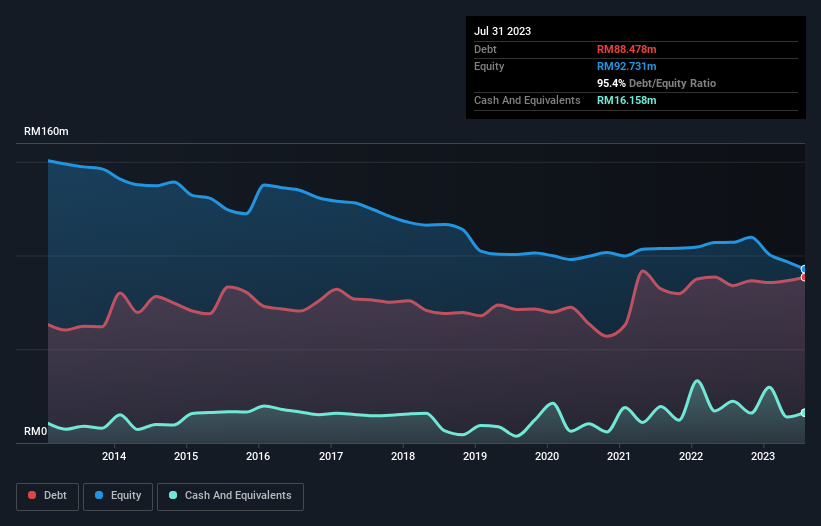- Malaysia
- /
- Basic Materials
- /
- KLSE:QUALITY
Is Quality Concrete Holdings Berhad (KLSE:QUALITY) Using Too Much Debt?
Legendary fund manager Li Lu (who Charlie Munger backed) once said, 'The biggest investment risk is not the volatility of prices, but whether you will suffer a permanent loss of capital.' So it seems the smart money knows that debt - which is usually involved in bankruptcies - is a very important factor, when you assess how risky a company is. We can see that Quality Concrete Holdings Berhad (KLSE:QUALITY) does use debt in its business. But the real question is whether this debt is making the company risky.
When Is Debt Dangerous?
Debt and other liabilities become risky for a business when it cannot easily fulfill those obligations, either with free cash flow or by raising capital at an attractive price. In the worst case scenario, a company can go bankrupt if it cannot pay its creditors. While that is not too common, we often do see indebted companies permanently diluting shareholders because lenders force them to raise capital at a distressed price. Having said that, the most common situation is where a company manages its debt reasonably well - and to its own advantage. When we examine debt levels, we first consider both cash and debt levels, together.
Check out our latest analysis for Quality Concrete Holdings Berhad
How Much Debt Does Quality Concrete Holdings Berhad Carry?
The image below, which you can click on for greater detail, shows that at July 2023 Quality Concrete Holdings Berhad had debt of RM88.5m, up from RM83.9m in one year. However, it does have RM16.2m in cash offsetting this, leading to net debt of about RM72.3m.

How Healthy Is Quality Concrete Holdings Berhad's Balance Sheet?
According to the last reported balance sheet, Quality Concrete Holdings Berhad had liabilities of RM165.3m due within 12 months, and liabilities of RM19.5m due beyond 12 months. Offsetting this, it had RM16.2m in cash and RM118.8m in receivables that were due within 12 months. So it has liabilities totalling RM49.9m more than its cash and near-term receivables, combined.
This is a mountain of leverage relative to its market capitalization of RM66.7m. This suggests shareholders would be heavily diluted if the company needed to shore up its balance sheet in a hurry. The balance sheet is clearly the area to focus on when you are analysing debt. But it is Quality Concrete Holdings Berhad's earnings that will influence how the balance sheet holds up in the future. So if you're keen to discover more about its earnings, it might be worth checking out this graph of its long term earnings trend.
Over 12 months, Quality Concrete Holdings Berhad made a loss at the EBIT level, and saw its revenue drop to RM194m, which is a fall of 4.9%. We would much prefer see growth.
Caveat Emptor
Importantly, Quality Concrete Holdings Berhad had an earnings before interest and tax (EBIT) loss over the last year. Indeed, it lost RM4.8m at the EBIT level. When we look at that and recall the liabilities on its balance sheet, relative to cash, it seems unwise to us for the company to have any debt. So we think its balance sheet is a little strained, though not beyond repair. However, it doesn't help that it burned through RM8.5m of cash over the last year. So in short it's a really risky stock. When analysing debt levels, the balance sheet is the obvious place to start. However, not all investment risk resides within the balance sheet - far from it. These risks can be hard to spot. Every company has them, and we've spotted 2 warning signs for Quality Concrete Holdings Berhad (of which 1 is concerning!) you should know about.
If, after all that, you're more interested in a fast growing company with a rock-solid balance sheet, then check out our list of net cash growth stocks without delay.
Valuation is complex, but we're here to simplify it.
Discover if Quality Concrete Holdings Berhad might be undervalued or overvalued with our detailed analysis, featuring fair value estimates, potential risks, dividends, insider trades, and its financial condition.
Access Free AnalysisHave feedback on this article? Concerned about the content? Get in touch with us directly. Alternatively, email editorial-team (at) simplywallst.com.
This article by Simply Wall St is general in nature. We provide commentary based on historical data and analyst forecasts only using an unbiased methodology and our articles are not intended to be financial advice. It does not constitute a recommendation to buy or sell any stock, and does not take account of your objectives, or your financial situation. We aim to bring you long-term focused analysis driven by fundamental data. Note that our analysis may not factor in the latest price-sensitive company announcements or qualitative material. Simply Wall St has no position in any stocks mentioned.
About KLSE:QUALITY
Quality Concrete Holdings Berhad
An investment holding company, manufactures, trades, and sells ready-mixed concrete and concrete products in Malaysia.
Slight risk and slightly overvalued.
Market Insights
Community Narratives




